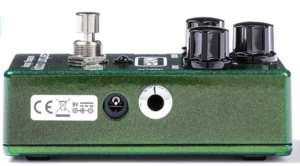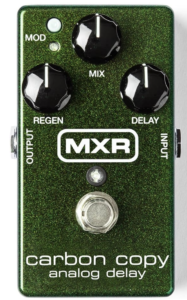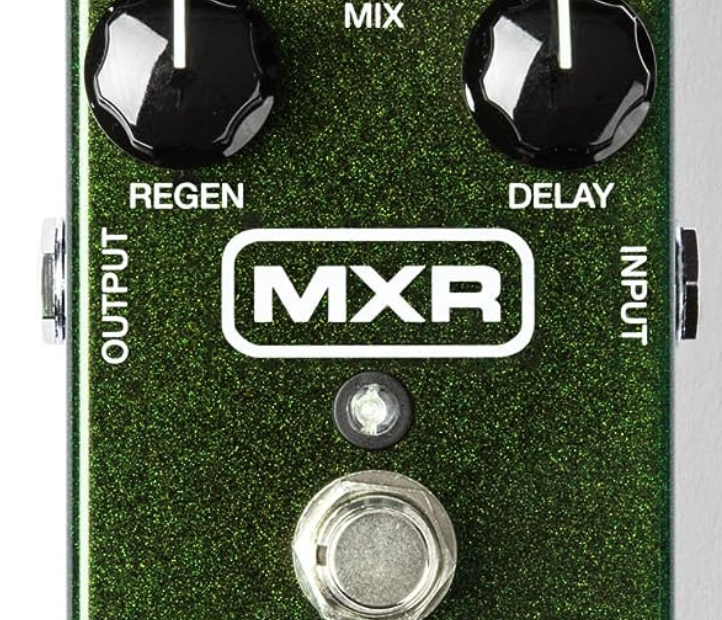The MXR M169 Carbon Copy Analog Delay Pedal is a popular and highly regarded effects pedal designed for electric guitar and other musical instruments. It is known for its warm and organic analog delay sound, making it a favorite among guitarists and musicians seeking classic delay tones.
Key Features
 The Carbon Copy [link] is an analog delay pedal, which means it uses analog circuitry to create its delay effects. This results in a warm and natural-sounding delay that many musicians prefer over digital alternatives.
The Carbon Copy [link] is an analog delay pedal, which means it uses analog circuitry to create its delay effects. This results in a warm and natural-sounding delay that many musicians prefer over digital alternatives.
The pedal features three main control knobs:
- Delay: Adjusts the length of the delay time, ranging from short slapback echoes to longer, ambient repeats.
- Regen (Regeneration): Controls the number of repeats or feedback. Turning it higher increases the number of echoes.
- Mix: Adjusts the balance between the dry and delayed signal, allowing you to blend the effect with your original sound.
One standout feature of the Carbon Copy is its modulation switch. When engaged, it adds a subtle modulation to the delayed signal, creating a lush and slightly chorused effect. This can be particularly useful for creating ambient and atmospheric sounds.
The pedal is equipped with true bypass switching, which means when the pedal is turned off, it won’t color your guitar signal or introduce any unwanted noise into your signal chain.
Also Read:
BOSS RC-505MKII Loop Station Pedal Review
JHS Pedals 3 Series Octave Reverb
Digitech DOD Meatbox Pedal Review
Source Audio C4 Synth Pedal Review
MOOER Acoustikar Acoustic Guitar Simulator Pedal
Boss GT-1 Guitar Multi-effects Pedal
Pedal Construction
MXR is known for its rugged and durable pedal enclosures, and the Carbon Copy is no exception. It’s built to withstand the rigors of the road and is housed in a sturdy metal casing.
The pedal typically operates on a standard 9-volt DC power supply. It also has a relatively low power consumption, making it suitable for use with most pedalboard setups.
The MXR M169 Carbon Copy has been used by a wide range of musicians across different genres. It’s well-suited for creating classic rock, blues, country, and ambient music tones. Many professional guitarists consider it a must-have delay pedal in their arsenal.
There are also variations of the Carbon Copy pedal, such as the Carbon Copy Deluxe, which offers additional features like tap tempo and extended delay time.
Advantages of Analog Delay
 Analog delay offers several advantages over digital delay, which make it a preferred choice for many musicians seeking a particular type of delay sound. Here are some of the advantages of analog delay:
Analog delay offers several advantages over digital delay, which make it a preferred choice for many musicians seeking a particular type of delay sound. Here are some of the advantages of analog delay:
- Warm and Organic Sound: Analog delay pedals are known for their warm, natural, and organic sound. They impart a certain character to the delayed signal that is often described as “warmer” and “dirtier” compared to the pristine and sometimes clinical sound of digital delay. This warmth can be particularly pleasing for certain musical styles and applications.
- Character and Saturation: Analog delay pedals often introduce subtle coloration and saturation to the delayed signal. This can add depth and character to your sound, making it more interesting and dynamic. Some guitarists prefer the way analog delay interacts with their instrument and amp, contributing to a unique tonal character.
- Smooth Decay: Analog delays typically have a smooth and natural decay of repeats. As the echoes fade out, they don’t abruptly cut off but gradually decay, contributing to a more musical and atmospheric quality.
- Feedback and Self-oscillation: Analog delay pedals are often capable of producing interesting feedback and self-oscillation effects when you increase the feedback control. This can lead to creative and experimental soundscapes that are challenging to achieve with digital delays.
- Less Digital Artifacts: Analog delay circuits are free from the digital artifacts that can sometimes be present in digital delay units, such as quantization noise, aliasing, and harshness in the repeats. This makes analog delay a great choice for musicians who want a more natural and vintage sound.
- Simplicity: Analog delay pedals are generally simpler to use than their digital counterparts. They typically have fewer controls and a more intuitive interface, making them a great choice for guitarists who want a straightforward delay effect without diving into complex settings.
- Vintage Aesthetic: Many analog delay pedals have a vintage look and feel, which can appeal to musicians who appreciate the aesthetics of classic gear.
How to Use
Using the MXR M169 Carbon Copy Analog Delay Pedal [link] is relatively straightforward, but it’s important to understand its controls and settings to get the most out of the pedal. Here’s a step-by-step guide on how to use it:
- Setup:
- Connect your guitar to the input of the Carbon Copy pedal.
- Connect the output of the pedal to your amplifier or the next pedal in your signal chain.
- Power the pedal using a 9-volt DC power supply.
- Basic Controls:
- Delay Knob: This controls the length of the delay time. Turn it clockwise for longer delay times and counterclockwise for shorter delays. Experiment with different settings to find the delay time that suits your music.
- Regen (Regeneration) Knob: Adjusts the number of repeats or feedback. Turning it up increases the number of echoes, while lower settings result in fewer repeats. Be cautious not to set it too high to avoid excessive feedback.
- Mix Knob: Controls the balance between the dry (original) and wet (delayed) signals. Turning it to the left emphasizes the dry signal, while turning it to the right emphasizes the delayed signal.
- Modulation and Bypass Switch
- The Carbon Copy has a modulation switch. When engaged, it adds a subtle modulation to the delayed signal. Try toggling this switch to see if you like the chorusing effect it adds. It’s especially useful for creating ambient and textured delay sounds.
- The pedal has a true bypass footswitch. Press it to engage or disengage the pedal. When the pedal is bypassed, your signal passes through unaffected. When engaged, your signal is processed through the delay circuit.
- Experiment and Fine-tune:
- Start with conservative settings on all knobs and gradually adjust them to your liking. You can create a wide range of delay effects, from subtle slapback echoes to longer, ambient reverbs.
- Pay attention to the interaction between the Delay, Regen, and Mix knobs. Adjust them to achieve the desired balance between the dry and wet signals and the number of repeats.
- Experiment with different delay times to match the tempo and feel of your music.
- Tap Tempo (if available):
- Note that the MXR M169 Carbon Copy is an analog delay pedal without a built-in tap tempo feature. If you need precise control over delay times and want to sync them with your music, you might consider using an external tap tempo pedal in your signal chain.
- Saving Your Favorite Settings:
- Once you find a setting you love, take note of the knob positions or mark them with tape or a marker to easily recreate your favorite sounds in the future.
The MXR M169 Carbon Copy Analog Delay Pedal is a beloved analog delay pedal known for its warm and rich delay tones. Its simple yet effective controls, modulation feature, and sturdy build quality have made it a popular choice among guitarists
